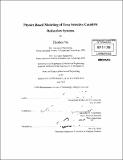Physics based modeling of urea selective catalytic reduction systems
Author(s)
Na, Hanbee
DownloadFull printable version (5.553Mb)
Other Contributors
Massachusetts Institute of Technology. Dept. of Mechanical Engineering.
Advisor
Anuradha M. Annaswamy.
Terms of use
Metadata
Show full item recordAbstract
This thesis addresses control-oriented modeling of urea-selective catalytic reduction (SCR) after-treatment systems used for reducing NO, emission in diesel vehicles. Starting from first-principles, appropriate simplifications are made in the underlying energy and species equations to yield simple governing equations of the Urea-SCR. The resulting nonlinear partial differential equations are discretized and linearized to yield a family of linear finite-dimensional state-space models of the SCR at different operating points. It is shown that this family of models can be reduced to three operating regions that are classified based on the relative NO, and NH3 concentrations. Within each region, parametric dependencies of the system on physical mechanisms are derived. A further model reduction is shown to be possible in each of the three regions resulting in a second-order linear model with sufficient accuracy. These models together with structured parametric dependencies on operating conditions set the stage for a systematic advanced control design that can lead to a high NO, conversion efficiency with minimal peak-slip in NH3. All model properties are validated using simulation studies of a high fidelity nonlinear model of the Urea-SCR, and compared with experimental data from a flow-reactor.
Description
Thesis (S.M.)--Massachusetts Institute of Technology, Dept. of Mechanical Engineering, 2010. Cataloged from PDF version of thesis. Includes bibliographical references (p. 62).
Date issued
2010Department
Massachusetts Institute of Technology. Department of Mechanical EngineeringPublisher
Massachusetts Institute of Technology
Keywords
Mechanical Engineering.